2013年七年级英语上册 Unit 1 Making new friends Topic 1 Welcome to china Section A教案 (新版)仁爱版
- 格式:doc
- 大小:467.50 KB
- 文档页数:20
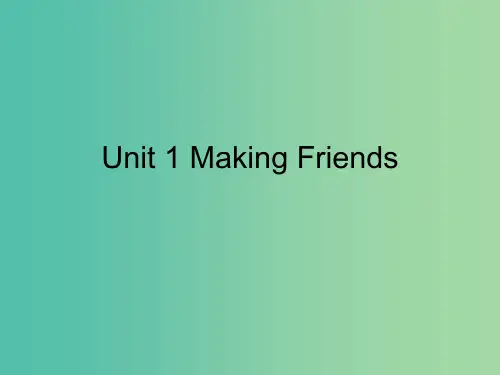
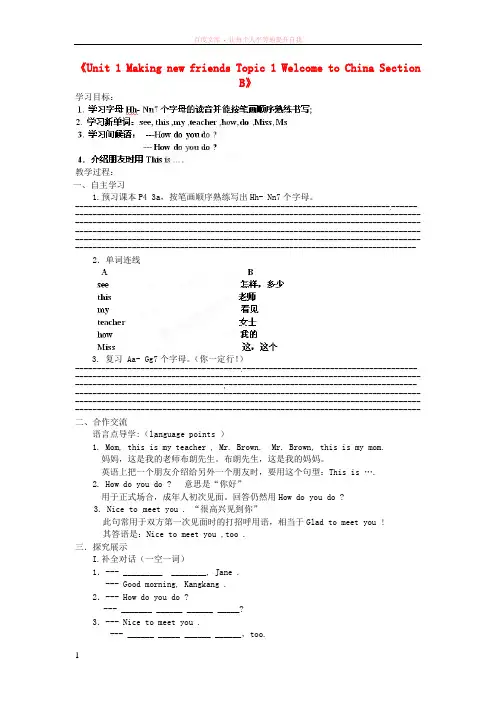
《Unit 1 Making new friends Topic 1 Welcome to China SectionB》学习目标:教学过程:一、自主学习1.预习课本P4 3a,按笔画顺序熟练写出Hh- Nn7个字母。
---------------------------------------------------------------------------------------------------------------------------------------------------------------------------------------------------------------------------------------------------------------------------------------------------------------------------------------------------------------------------------------------------------------------------------------------------------------------------------------- 2.单词连线3. 复习 Aa- Gg7个字母。
(你一定行!)---------------------------------------------------------------------------------------------------------------------------------------------------------------------------------------------------------------------------------------------------------------------------------------------------------------------------------------------------------------------------------------------------------------------------------------------------------------------------------------- 二、合作交流语言点导学:(language points )1. Mom, this is my teacher , Mr. Brown. Mr. Brown, this is my mom.妈妈,这是我的老师布朗先生。
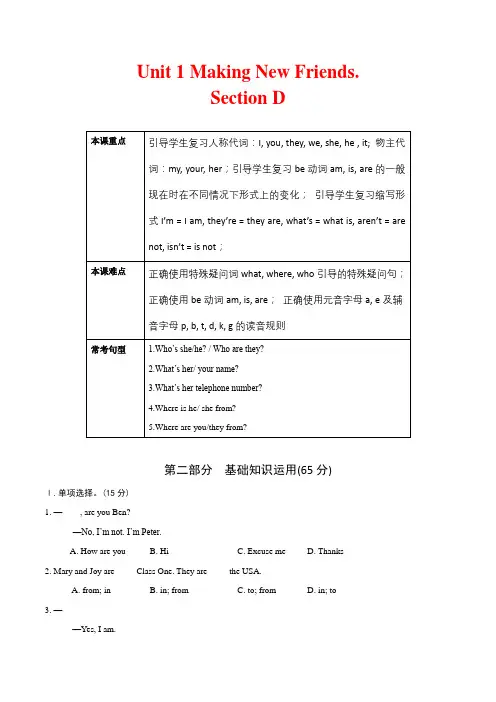
Unit 1 Making New Friends.Section D第二部分基础知识运用(65分)Ⅰ.单项选择。
(15分)1. —____, are you Ben?—No, I’m not. I’m Peter.A. How are youB. HiC. Excuse meD. Thanks2. Mary and Joy are ____ Class One. They are ____ the USA.A. from; inB. in; fromC. to; fromD. in; to3. —____—Yes, I am.A. What’s your name?B. What are you?C. How are you?D. Are you Mike?4. —Is this ____ car?—Yes, it’s ____ English car.A. a; anB. a; aC. an; anD. an; a5. —What are those?—____ are cakes.A. ThatB. TheseC. ItD. They6. —What’s that ____ English?—It’s a desk.A. fromB. toC. inD. /7. —____ is she?—She’s fine.A. How oldB. HowC. WhereD. What8. —Is her name Kate?—____A. Yes, she is.B. No, she isn’t.C. Yes, it’s.D. No, it isn’t.9. —I’m in Class 4. Are you in Class 4, ____?—Yes, I am.A. OKB. tooC. andD. excuse10. This is my teacher, Miss Chen. ____ is from Hebei.A. SheB. HeC. HerD. His11. Linda is fifteen ____. She is in Class 1, Grade 9.A. yearB. yearsC. years oldD. year old12. —Welcome to our school.—____A. OK.B. Thanks.C. Excuse me.D. Hello.13. —What ____ is Jane in?—She is in ____ Six.A. Class; ClassB. Class; classC. class; classD. class; Class14.当你被介绍认识某人后, 你应该说: “____”。
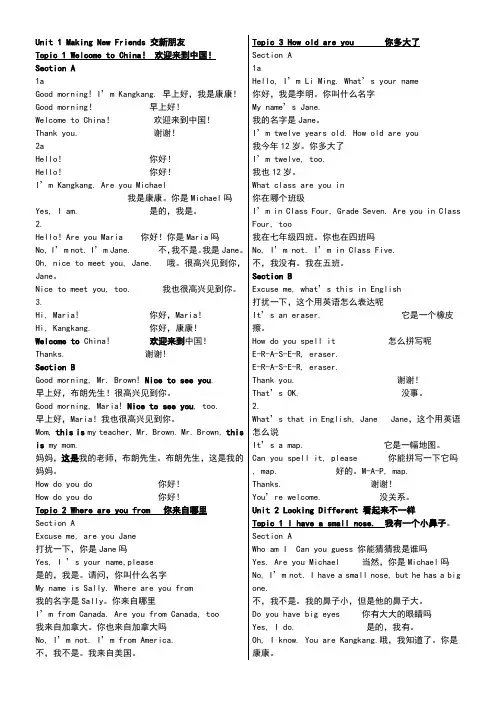
Unit 1 Making New Friends 交新朋友Topic 1 Welcome to China!欢迎来到中国!Section A1aGood morning! I’m Kangkang.早上好,我是康康!Good morning!早上好!Welcome to China!欢迎来到中国!Thank you. 谢谢!2aHello!你好!Hello!你好!I’m Kangkang. Are you Michael我是康康。
你是Michael吗Yes, I am. 是的,我是。
2.Hello!Are you Maria 你好!你是Maria吗No, I’m not. I’m Jane. 不,我不是。
我是Jane。
Oh, nice to meet you, Jane. 哦。
很高兴见到你,Jane。
Nice to meet you, too. 我也很高兴见到你。
3.Hi, Maria! 你好,Maria!Hi, Kangkang. 你好,康康!Welcome to China! 欢迎来到中国!Thanks. 谢谢!Section BGood morning, Mr. Brown! Nice to see you.早上好,布朗先生!很高兴见到你。
Good morning, Maria! Nice to see you, too.早上好,Maria!我也很高兴见到你。
Mom, this is my teacher, Mr. Brown. Mr. Brown, this is my mom.妈妈,这是我的老师,布朗先生。
布朗先生,这是我的妈妈。
How do you do 你好!How do you do 你好!Topic 2 Where are you from 你来自哪里Section AExcuse me, are you Jane打扰一下,你是Jane吗Yes, I ’s your name,please是的,我是。
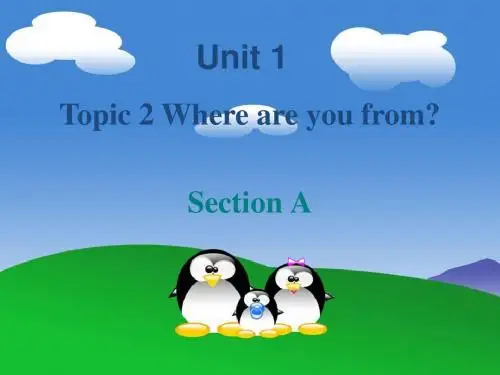
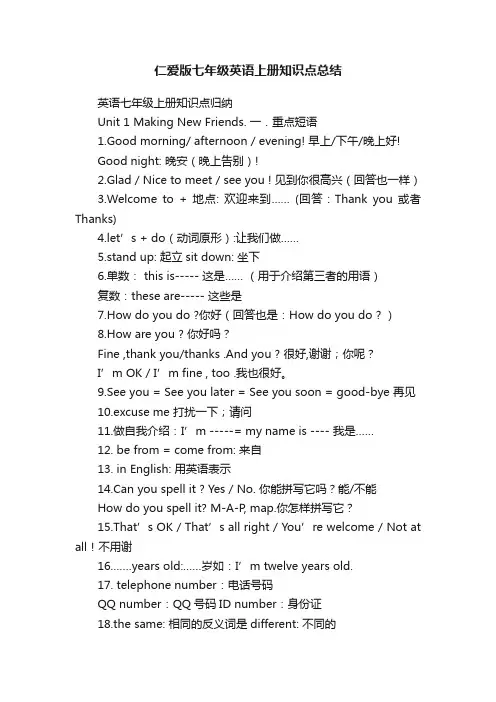
仁爱版七年级英语上册知识点总结英语七年级上册知识点归纳Unit 1 Making New Friends. 一.重点短语1.Good morning/ afternoon / evening! 早上/下午/晚上好!Good night: 晚安(晚上告别)!2.Glad / Nice to meet / see you ! 见到你很高兴(回答也一样)3.Welcome to + 地点: 欢迎来到…… (回答:Thank you 或者Thanks)4.let’s + do(动词原形):让我们做……5.stand up: 起立sit down: 坐下6.单数: this is----- 这是…… (用于介绍第三者的用语)复数:these are----- 这些是7.How do you do ?你好(回答也是:How do you do ? )8.How are you ? 你好吗?Fine ,thank you/thanks .And you ? 很好,谢谢;你呢?I’m OK / I’m fine , too .我也很好。
9.See you = See you later = See you soon = good-bye 再见10.excuse me 打扰一下;请问11.做自我介绍:I’m -----= my name is ---- 我是……12. be from = come from: 来自13. in English: 用英语表示14.Can you spell it ? Yes / No. 你能拼写它吗?能/不能How do you spell it? M-A-P, map.你怎样拼写它?15.That’s OK / That’s all right / You’re welcome / Not at all!不用谢16.……years old:……岁如:I’m twelve years old.17. telephone number:电话号码QQ number:QQ号码ID number:身份证18.the same: 相同的反义词是different: 不同的例: We are in the same grade, but we are in different classes.二.重点句型:1. What is your name ? 你的名字是什么?2. Where +be +主语+ from? 某人来自于哪里?(回答:主语+be+地点)eg:Where are you from? I am from China.3. How old + be + 主语?某人几岁?(回答:主语+ be + 数字)例:How old are you ? I’m twelve.4.What is your telephone number? 你的电话号码是多少?回答:My telephone number is--或者It’s -- 注意:读出号码的时候要逐个读出。
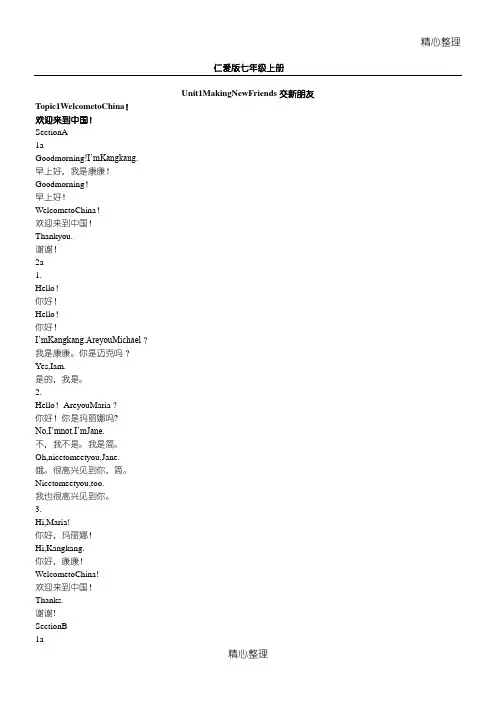
精心整理仁爱版七年级上册Unit1MakingNewFriends交新朋友Topic1WelcometoChina!欢迎来到中国!SectionA1aGoodmorning!I’mKangkang.早上好,我是康康!Goodmorning!早上好!WelcometoChina!欢迎来到中国!Thankyou.谢谢!2a1.Hello!你好!Hello!你好!I’mKangkang.AreyouMichael?我是康康。
你是迈克吗?Yes,Iam.是的,我是。
2.Hello!AreyouMaria?你好!你是玛丽娜吗?No,I’mnot.I’mJane.不,我不是。
我是简。
Oh,nicetomeetyou,Jane.哦。
很高兴见到你,简。
Nicetomeetyou,too.我也很高兴见到你。
3.Hi,Maria!你好,玛丽娜!Hi,Kangkang.你好,康康!WelcometoChina!欢迎来到中国!Thanks.谢谢!SectionB1aGoodmorning,Mr.Brown!Nicetoseeyou.早上好,布朗先生!很高兴见到你。
Goodmorning,Maria!Nicetoseeyou,too.早上好,玛丽娜!我也很高兴见到你。
Mom,thisismyteacher,Mr.Brown.Mr.Brown,.thisismymom.妈妈,这是我的老师,布朗先生。
布朗先生,这是我的妈妈。
Howdoyoudo?你好!Howdoyoudo?你好!Topic2Whereareyoufrom?你来自哪里?SectionA1aExcuseme,areyouJane?打扰一下,你是简吗?Yes,Iam.W hat’syourname,please?是的,我是。
请问,你叫什么名字?MynameisSally.Whereareyoufrom?我的名字是莎丽。
你来自哪里?I’mfromCanada.AreyoufromCanada,too?我来自加拿大。
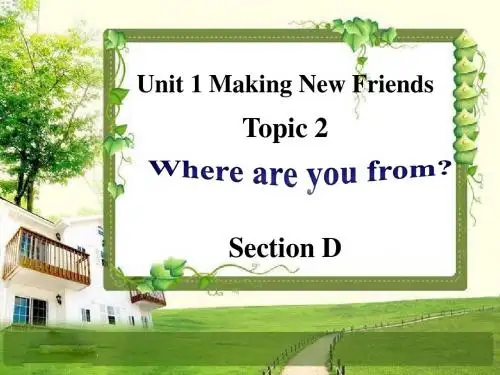
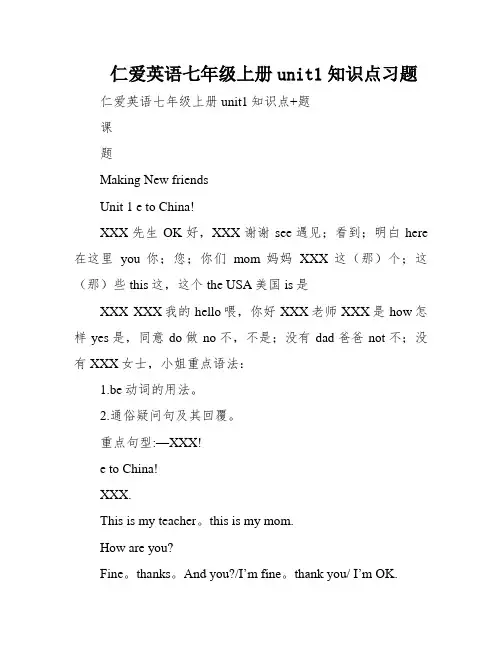
仁爱英语七年级上册unit1知识点习题仁爱英语七年级上册unit1知识点+题课题Making New friendsUnit 1 e to China!XXX先生OK好,XXX谢谢see遇见;看到;明白here 在这里you你;您;你们mom妈妈XXX这(那)个;这(那)些this这,这个the USA美国is是XXX XXX我的hello喂,你好XXX老师XXX是how怎样yes是,同意do做no不,不是;没有dad爸爸not不;没有XXX女士,小姐重点语法:1.be动词的用法。
2.通俗疑问句及其回覆。
重点句型:—XXX!e to China!XXX.This is my teacher。
this is my mom.How are you?Fine。
thanks。
And you?/I’m fine。
thank you/ I’m OK.XXX you.I’m XXX。
Miss Wang。
this is Ms.Jone.Are you Maria?重点详解:e to +地点名词:表示欢迎来到某地。
e来表示欢迎时,常用Thank you。
/Thanks.来回答。
例子:e to China/ Beijing/Shanghai!回覆:Thank you。
/Thanks.2.Nice to meet you.常用于(1)在两人初次见面经介绍后。
2)大概用于良久不见,有时重逢时。
回覆:–Nice to meet you。
too.区分:Nice to see you用于熟人之间晤面时分的规矩用语。
3.I am=I’m常用其进行自我介绍:I am XXX.我是XXX。
4.向别人介绍第三方时通常用:This is。
句型。
例子:Mom。
this is my teacher,Mr。
Lee.妈妈,这是我的教师,XXX(男性)。
仁爱英语七年级上册unit1常识点+题Mom。
this is my XXX。
XXX.妈妈,这是我的朋友,XXX。
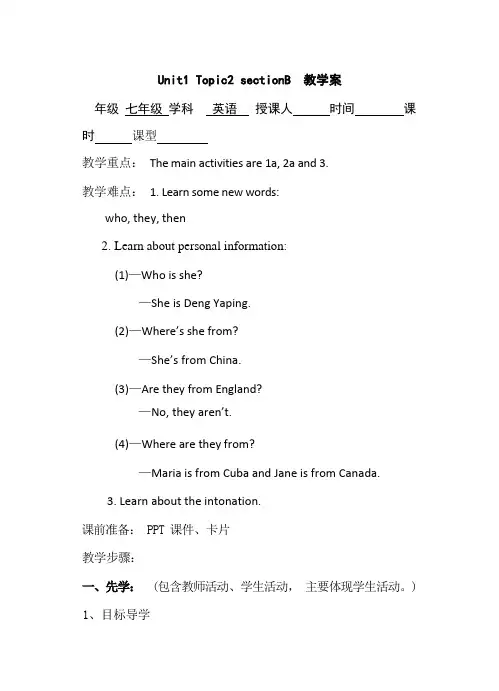
年级七年级学科英语授课人时间课时课型教学重点:The main activities are 1a, 2a and 3.教学难点:1. Learn some new words:who, they, then2. Learn about personal information:(1)—Who is she?—She is Deng Yaping.(2)—Where’s she f rom?—She’s from China.(3)—Are they from England?—No, they aren’t.(4)—Where are they from?—Maria is from Cuba and Jane is from Canada.3. Learn about the intonation.课前准备: PPT 课件、卡片教学步骤:(包含教师活动、学生活动,主要体现学生活动。
)1、目标导学(出示图片,复习旧知识引出新知识。
)T: Who is he?(出示Tony 图片。
)Ss: He is Tony.T: Where is he from?2、自学指导(拿出准备好的卡片进行问答,卡片上写有Canada, England, the U.S.A., Japan, Cuba, China 这些国家的名称,背面写有来自相应国家的人物Jane, Tony, Sally, Yukio, Maria, Kangkang 。
)T: Who is this?(教师解释并示意学生回答。
)Ss:This is Jane.T: Great, she is Jane, and she is from Canada.3、学生自学通过反复操练询问名字和来自的地方的句型,巩固所学目标语言,以达到运用英语进行交流的目的。
(结合学生的自身情况,给学生两分钟时间,两人一组操练如下句型。
让学生站起来或到台前来表演。
)4、学后检测(再给学生两分钟时间,两人一组操练下列句型。
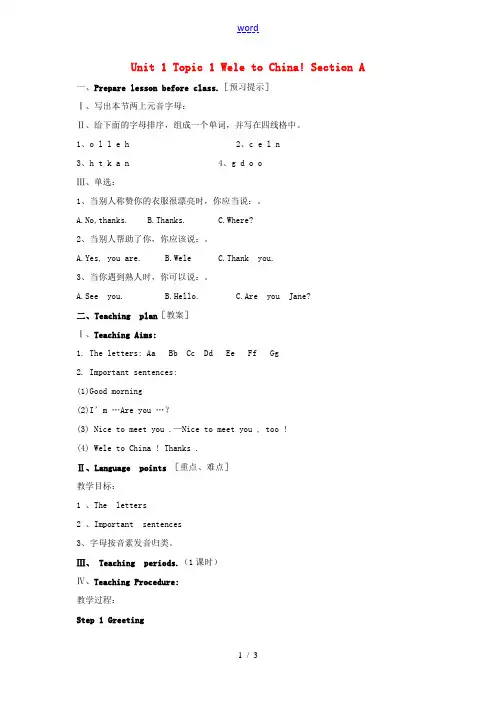
Unit 1 Topic 1 Wele to China! Section A 一、P repare lesson before class.[预习提示]Ⅰ、写出本节两上元音字母:Ⅱ、给下面的字母排序,组成一个单词,并写在四线格中。
1、o l l e h2、c e l n3、h t k a n4、g d o oⅢ、单选:1、当别人称赞你的衣服很漂亮时,你应当说:。
A.No,thanks.B.Thanks.C.Where?2、当别人帮助了你,你应该说:。
A.Yes, you are.B.WeleC.Thank you.3、当你遇到熟人时,你可以说:。
A.See you.B.Hello.C.Are you Jane?二、Teaching plan[教案]Ⅰ、Teaching Aims:1. The letters: Aa Bb Cc Dd Ee Ff Gg2. Important sentences:(1)Good morning(2)I’m …Are you …?(3) Nice to meet you .—Nice to meet you , too !(4) Wele to China ! Thanks .Ⅱ、Language points [重点、难点]教学目标:1 、The letters2 、Important sentences3、字母按音素发音归类。
Ⅲ、 Teaching periods.(1课时)Ⅳ、Teaching Procedure:教学过程:Step 1 GreetingT: Good morning ,class .S: Good morning ,teacher .Step 2 The new words:Good , morning , hi , hello , I am , are , you , yes , nice , to , meet , too , wele , China , thank .Step 3 Learn the sentences1. Good morning .—Good morning .2. Hi .—Hello .3. I’m Kang kang .Are you Michael ? Yes ,I am .4. Nice to meet you .Nice to meet you ,too .5. Wele to China !Thanks .Step 4 Read and listen to the tapeStep 5 Practice the conversationS1: Good morning ./Hello ! S2: Good morning ./Hello !S1: I’m …Are you …?S2: Yes ,I am .S1: Nice to meet you ! S2: Nice to meet you ,too .Step 6: Learn and make some sentences .1. Wele to China ! —Thanks .2. Wele to ××!—Thanks .3. Are you …? Yes ,I am ./No ,I’m not .Step 7: Learn the letters .Aa Bb Cc Dd Ee Gg FfStep 8: WriteStep 9:Rolling out[拓展延伸]Aa[ei]Bb[bi:] Cc[si:] Dd[di:] Ee [i:]Gg [dЗi:]Ff[ef]Step 10:Summary.[小结]Learn the new dialogue by designing situations.Step 11: Test [反馈测试]Ⅰ.填入所缺的字母Aa Dd GgⅡ.单项选择:( )1. _________you Li Ping ? Yes ,I _________ .A. Are ; amB. I ; amC. Are ; areD. Is ; am ( )2. _________.Nice to meet you , too .A. Fine ,thank you .B. Thank .C. Yes ,I am .D. Nice to meet you . ( )3.Are you Li Weikang ? __________ .A. Yes ,I’m .B. No ,I’m .C. Yes ,I am .D. No ,I am . ( )4.Hi ,Jane .___________ .A. Maria , hi .B. Kangkang ,hi .C. Good morning .D. Hi ,Michael . ( )5. __________ .Thanks .A. Nice to meet you .B. Good morning .C. Yes ,I am .D. Wele to Beijing Ren’ai .Internationa School !Ⅲ.从Ⅱ栏中选出与Ⅰ相对应的答语Ⅰ Ⅱ( )1. Good morning . A. Fine ,thanks .( )2. Hello ! B. Nice to meet you ,too .( )3. Nice to meet you . C. No ,I’m not .( )4.A re you Kangkang ? D. Good morning .( )5. How are you ? E. Hi ,Mr. Zhang .Step 12 Blackboard Design[板书]Section AGood morning/Hello /HiNice to meet/see you .Wele to China !Thanks .Are you …? Yes ,I am ./ No ,I’m not.Aa Bb Cc Dd Ee Ff Gg。
Unit 1 Making New FriendsSection ATopic 1 Welcome to China!The main activities are 1a, 2a and 3a. 本课重点活动是1a, 2a和3a。
Ⅰ.Teaching aims and demands 教学目标1.(1)Learn the letters Aa-Gg.(2)Learn some new words:good, morning, welcome, to, China, thank, you, hello, I, am, are, yes, no, not, nice, meet, too2. Learn about greetings and introductions:(1)—Good morning.—Good morning.(2)—Welcome to China!—Thank you./Thanks.(3)—Hello/Hi!—Hello/Hi!(4)—I’m … Are you …?—Yes, I am./No, I’m not. I’m …(5)—Nice to meet you.—Nice to meet you, too.Ⅱ. Teaching aids 教具投影仪/教学挂图/录音机/字母卡片/小黑板Ⅲ. Five-finger Teaching Plan 五指教学方案Step 1 Introduction 第一步介绍(时间:6分钟)本节课是开篇,教师应向全体学生说明以下两点:1.学习英语的重要性。
2.学习英语的正确方法。
目的:激发学生学习英语的兴趣,使学生树立自信心,养成良好的学习习惯和形成有效的学习策略。
Step 2 Presentation 第二步呈现(时间:9分钟)呈现简单的打招呼用语,并进行听说练习,学以致用。
1. (运用真实情境,让学生学会如何与他人简单地打招呼。
)(1)(教师向一名学生做手势以示打招呼。
)T: Hello!S1: Hello!(启发学生回答。
)(板书Hello!让学生猜测其意思并掌握。
)hello(师生互动操练Hello!)T: Hello!Ss: Hello!)(同时教师可以请一位学生帮忙,示范熟人之间应怎样打招呼,并让学生之间用真实姓名依次操练。
)T: Please look at us and see how we are greeting. Then you can use your names to greet each other.(教师给以适当的汉语提示。
)T: Hi, Li Lei!S2: H i, Mr./Miss××.S3: H i, Zhang Hua!S4: H i, Chen Jun!S5: H ello, Zhou Jie!S6: H ello, Zheng Hua!(3)(教师亲切地用手势跟同学们打招呼。
)T: Good morning!(重复几遍后,启发学生回答。
)Ss: Good morning!)(让学生猜测Good morning!的意思,教师给予提示:早上见面问好可用Good morning!代替Hello!师生互动操练Good morning!)(教师让学生用自己的真实姓名互动操练Hi!/Hello!/Good morning!)S7: H i! S8.S8: H i! S7.S9: H ello! S10.S10:Hello! S9.S11:Good morning! S12.S12:Good morning! S11.…(对学生的表演给予掌声鼓励。
)2. (用投影仪或教学挂图出示1a,图中康康在接机大厅接人,三个外国学生刚下飞机。
问学生:他们之间应该怎样打招呼呢?)Ss: Hi!/Hello!/Good morning!China,板书并要求学生掌握。
)T: Good morning! Welcome to China!Ss: Good morning! Thank you./Thanks.(帮助学生回答。
))(师生互动操练以上对话。
)3. (播放1a录音, 让学生跟读, 注意模仿语音语调。
)T: Listen to the tape and follow. Pay attention to the pronunciation andintonation.4. (出示四个小主人公的人物图,让学生认识他们,并教学生读Kangkang, Michael, Jane, Maria四个名字,教师播放1b录音,完成1b。
核对答案并打分。
)Step 3 Consolidation第三步巩固(时间:12分钟)通过师生对话,教学自我介绍的功能用语,并进行练习和表演,让学生运用所学英语进行简单交际。
1. (1)(教学I’m … Are you …? Yes, I am./No, I’m not.)(教师找两名男生和两名女生分别扮演Kangkang, Michael, Jane, Maria。
分别教他们说I’m Kangkang. I’m Michael. I’m Jane. I’m Maria. 引出I’m=I am. 再问Are you …?Yes, I am./ No, I am not.)(教师向全班同学介绍自己,然后请几个学生向全班同学打招呼,并做自我介绍。
)T: Hi!/Hello! I’m … (教师手指着自己,并引导学生做自我介绍。
)S1: Hi!/Hello! I’m Wu San. (S1站起来。
)S2: Hi!/Hello! I’m Wang Xiang. (S2站起来。
)S3: Hi!/Hello! I’m Wei Hua. (S3站起来。
)(教师接着对刚刚做过自我介绍的学生进行提问,练习上面板书的另两个句式。
)T: I’m … Are you Wei Hua?S3: Yes, I am. (学生点头,这时教师引导学生作答。
)T: I’m … Are you Li Feng?S2: No, I’m not. I’m Wang Xiang.(让学生两人一组进行类似操练。
)(2)(再找来一名学生S4,教学Nice to meet you. Nice to meet you, too.的情景用法。
(教师示范表演。
)T: Hello! I’m … Are you Liu Siyang?S4: No, I’m not. I’m Wendy.T: Oh, nice to meet you, Wendy.S4: Nice to meet you, too. (教师引导学生作答。
)(让学生互相问答,借此机会运用类似的对话认识同学。
)2. (播放3a录音,让学生跟读,注意模仿语音语调并进行人机对话。
完成3a。
)T: Listen to the tape and repeat. Pay attention to the pronunciation and intonation, please. Then practice the dialog with the tape. (教师给以适当汉语提示。
)3. (让学生自由组合操练1a和3a,然后两人一组上讲台表演。
进行小组竞赛,巩固1a和3a所学内容。
完成3b。
)T: Practice a dialog according to 1a and 3a in pairs, then act it out. (教师给以适当汉语提示。
)S1: Good morning!S2: Good morning!S1: I’m … Are you …?S2: Yes, I am.S1: Nice to meet you.S2: Nice to meet you, too.S1: Welcome to China!S2: Thanks./Thank you.4. (再让学生四人一组上台表演打招呼和做自我介绍。
)T: Act out the dialog with your own names.S3: H i!S4: H i!S3: I’m … Are you …?S4: Y es, I am.S3: H ello! Are you …?S5: N o, I’m not. I’m …S3: N ice to meet you.S5: N ice to meet you, too.S3: H i! Are you …?S6: Y es, I am.S3: W elcome to China!S6: T hanks./Thank you.Step 4 Practice 第四步练习(时间:10分钟)通过教学读写字母Aa-Gg并做字母接力游戏,培养学生的合作精神,激发学生的学习兴趣。
1. (学习字母Aa-Gg。
)(1)(教师逐个出示字母卡片,先示范字母的读音,要求学生仔细听,认真观察教师的口型,再进行模仿。
每个字母都要用升降调来读。
)T: Listen to me and read the letters after me. Learn Aa-Gg by heart.(教师先教学字母Aa-Gg,然后全体学生跟读Aa,Bb, Cc, Dd, Ee, Ff, Gg。
)T: Aa Bb Cc Dd Ee Ff GgSs: Aa Bb Cc Dd Ee Ff Gg(2)(告诉学生,每个英文字母都有印刷体和书写体、大写和小写之分。
关于字母的书写,要严格要求学生用四线格的练习本,按笔顺和格式书写。
逐个板书英文字母。
书写每个字母时,教师要做好示范,从起笔到收笔,用几笔写成的都要示范清楚。
带着学生用右食指在空中模仿,然后让学生在四线格上临摹。
完成2a。
)T: Now let’s learn how to write the letters.2. (1)(英语字母接力游戏。
)T: Now let’s play a game.(由第一排第一个同学快速说出“A”,第二个同学快速接上“B”。
依次C,D,E,F,G,A,B……)T: The first student in the first row says “A” quickly, and the second studentsays “B” and then other students say C, D, E, F, G, A, B … one by one. (教师给以汉语提示。
)(待上个游戏完成后,再要求第一个同学报出“AB”,第二个同学快速接上“BC”,第三个同学快速接上“CD”……以此类推,直到全班同学都参与进去。
)T: Well done! Now the first one says “AB”, the second one says “BC”quickly, the third one says “CD” and so on. (教师给以汉语提示。